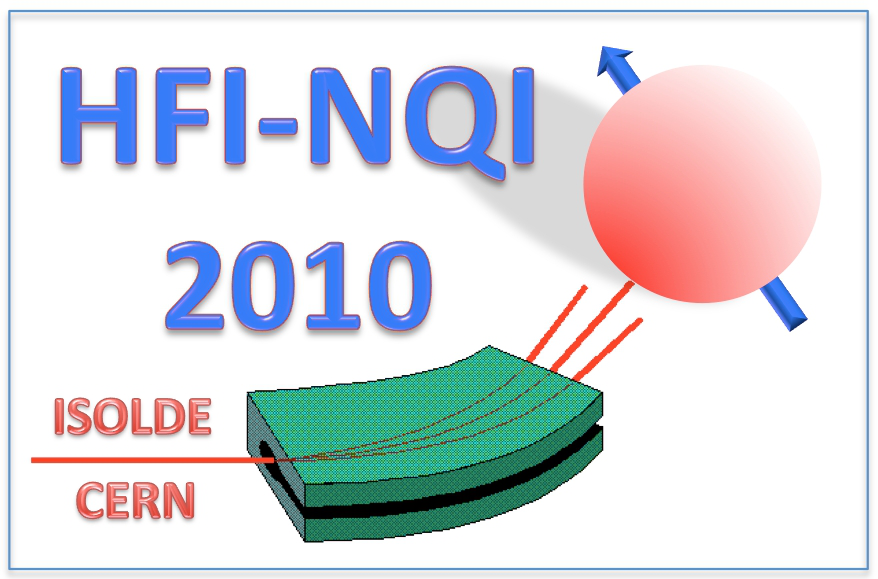Mr
Diego Richard
(Departamento de Física e Instituto de Física La Plata (IFLP, CONICET-UNLP), Facultad de Ciencias Exactas, Universidad Nacional de La Plata, CC 67, 1900 La Plata, Argentina.)Mr
Emiliano Luis Muñoz
(Departamento de Física e Instituto de Física La Plata (IFLP, CONICET-UNLP), Facultad de Ciencias Exactas, Universidad Nacional de La Plata, CC 67, 1900 La Plata)
The combined experimental and theoretical approach based on electric-field gradient (EFG) determinations by means of hyperfine interaction measurements and ab initio predictions at impurity atoms has been shown to be a powerful tool to unravel structural and electronic characterizations of impurities in solids, in particular in semiconductor oxides [1-3]. In this work, PAC experiments using 111In-difussed Sc2O3 polycrystals have been performed at the IPEN facility in order to measure the Electric-Field Gradient (EFG) at (111In (EC)-->) 111Cd nuclei located at the cation site of the semiconductor lattice. The experimental results are compared with ab initio calculations performed with the Full-Potential Augmented Plane Wave plus local orbital (FP-APW+lo) method in the framework of the Density Functional Theory (DFT). The PAC experiments were carried out in the temperature range 10 K – 900 K. The PAC spectra obtained in these measurements shows two very well-defined quadrupole frequencies along the whole temperature range, pointing to the fact that 100% of the probes are located at both nonequivalent cation sites of the bixbyite structure. Nevertheless, the spectra are dampened at certain intermediate temperatures, indicating the presence of dynamic hyperfine interactions that were analyzed with a perturbation factor based on the Bäverstam and Othaz model [4,5]. The FPAPW+lo calculations were performed using the Wien2K code. From the ab initio-experimental comparison, we can conclude that the Cd impurities localized at the axially symmetric D sites of the crystal structure do not present dynamic interactions while that the Cd probes localized at the asymmetric C sites present appreciable dynamic interactions attributed to the so-called after-effects that follow the electron-capture decay of the 111In parent isotope of the 111Cd impurity tracer. This scenario could be supported in terms of the EFG behaviour, predicted by the ab initio calculations, at Cd impurities as a function of the charge state of the impurity located at the different cation sites of the structure.
Summary
References
[1] Anisotropic Relaxations Introduced by Cd Impurities in Rutile TiO2: First-Principles Calculations and Experimental Support
L.A. Errico, G. Fabricius, M. Rentería, P. de la Presa, and M. Forker.
Physical Review Letters 89, 55503 (2002).
[2] Metal Impurities in an Oxide: Ab Initio Study of Electronic and Structural Properties of Cd in Rutile TiO2
L.A. Errico, G. Fabricius, and M. Rentería.
Physical Review B 67, 144104 (2003).
[3] Metal Impurities in an Oxide: Ab Initio Study of Electronic and Structural Properties of Cd in Rutile TiO2
G. N. Darriba, L. A. Errico, P. D. Eversheim, G. Fabricius, and M. Rentería.
Physical Review B 79, 115213 (2009).
[4] U. Bäverstam, R. Othaz, N. De Sousa and B. Ringström, Nucl. Phys. A186, 500 (1972).
[5] A. Abragam and R. V. Pound, Phys. Rev. 92, 943 (1953).
| Are you a student, a delegate from developing countries or a participant with physical needs and would like to apply for a sponsored accomodation. Please answer with yes or no. |
yes
|
| Please specify whether you would prefer an oral or poster contribution. |
poster contribution
|
Mr
Emiliano Luis Muñoz
(Departamento de Física e Instituto de Física La Plata (IFLP, CONICET-UNLP), Facultad de Ciencias Exactas, Universidad Nacional de La Plata, CC 67, 1900 La Plata)
Prof.
Arthur Wilson Carbonari
(Instituto de Pesquisas Energéticas y Nucleares-IPEN-CNEN/SP, São Paulo, Brazil)
Mr
Diego Richard
(Departamento de Física e Instituto de Física La Plata (IFLP, CONICET-UNLP), Facultad de Ciencias Exactas, Universidad Nacional de La Plata, CC 67, 1900 La Plata, Argentina.)
Prof.
Leonardo Antonio Errico
(Departamento de Física e Instituto de Física La Plata (IFLP, CONICET-UNLP), Facultad de Ciencias Exactas, Universidad Nacional de La Plata, CC 67, 1900 La Plata, Argentina. Universidad Nacional del Noroeste Bonaerense (UNNOBA), Monteagudo 2772, 2700 Pergamino, Buenos Aires, Argentina.)
Prof.
Mario Rentería
(Departamento de Física e Instituto de Física La Plata (IFLP, CONICET-UNLP), Facultad de Ciencias Exactas, Universidad Nacional de La Plata, CC 67, 1900 La Plata, Argentina.)
